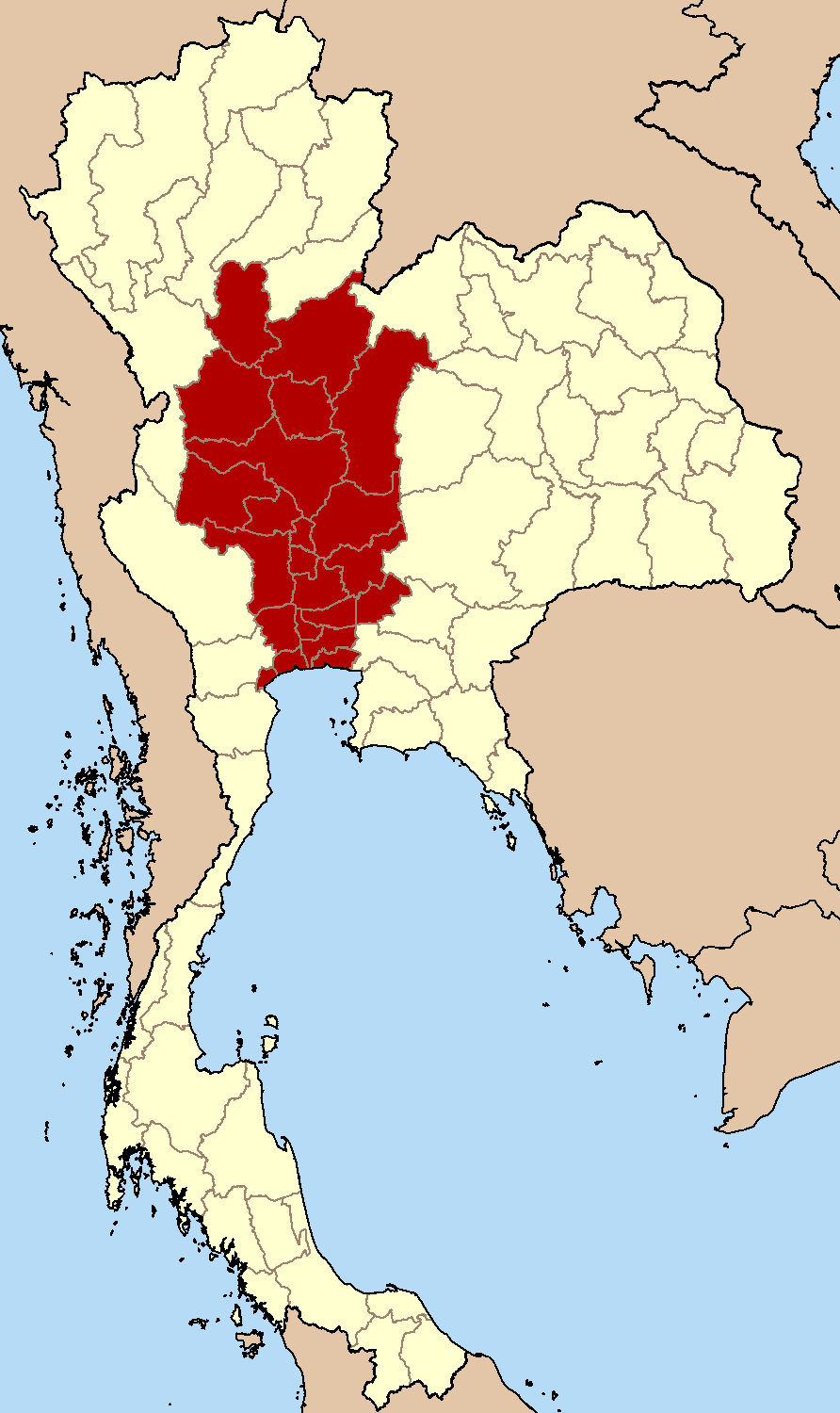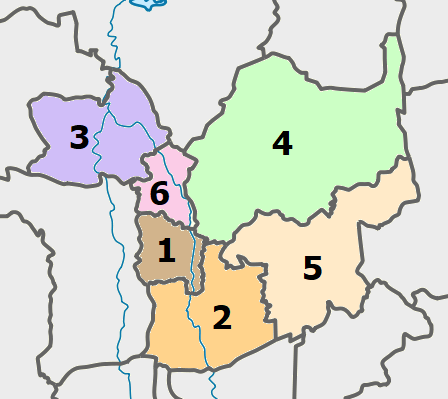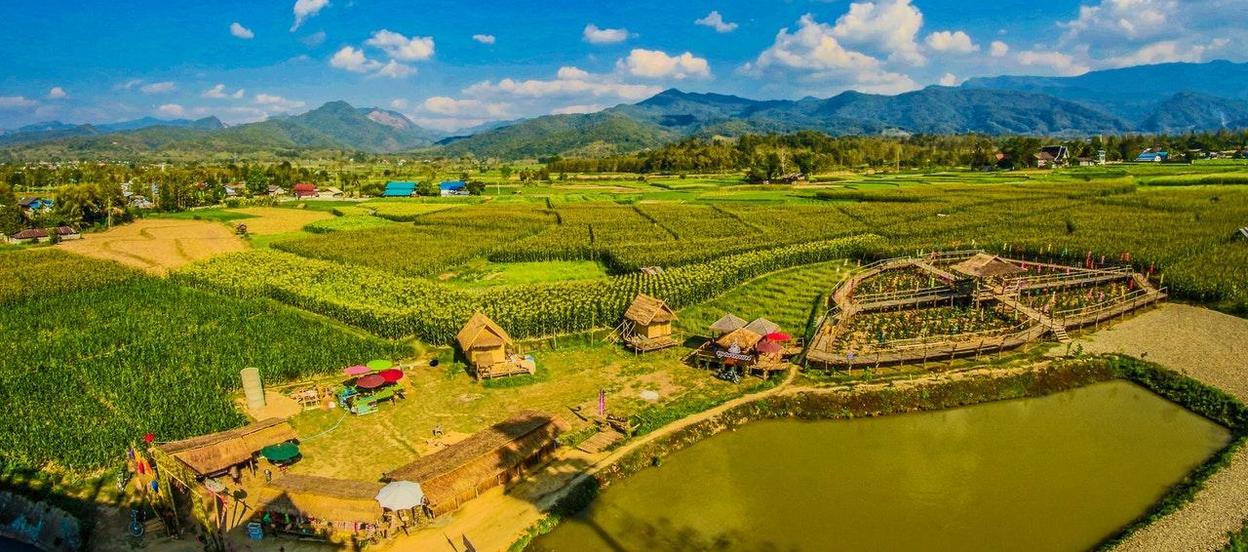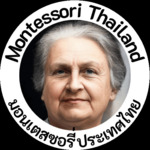Central Region
# **Central Region of Thailand**
**Central Public, Private, and International Montessori School Directory**
## 
Living in or moving to the Central Region of Thailand and looking for an International Montessori School?
---
## Central Region Public Montessori Schools
**(Thai and Montessori Curriculum)**
The school year for schools following the Thai curriculum starts in May and ends in March. April is considered Holiday. The half-term break is in October. Students finishing Elementary Grades (Pratom) 3, 6, Secondary Grades (Mathayom) 3, and 6 have to pass a Thai National Test (O-Net). In April 2004 the Pilot Project for The Development of the Child’s Potential in Small Government School using the Montessori Approach. The first [AMI](https://en.wikipedia.org/wiki/Association_Montessori_Internationale) 3 to 6 Diploma Course in Thailand started in 2006 and a second course started in 2009, the third course in 2011, and some more followed.
**For some public schools, we could not find the correct location until now but they appear in papers, scripts, and presentations. Please help us to make this list complete. Thanks**
## [Ayutthaya](https://montessori-international.com/spaces?page=1&keyword=Thailand+Ayutthaya)
* 2 Montessori Schools (location not available)
## [Chachoengsao](https://montessori-international.com/spaces?page=1&keyword=Thailand+Chachoengsao)
* 1 Montessori School (location not available)
## [Chai Nat](https://montessori-international.com/spaces?page=1&keyword=Thailand+Chai+Nat)
* 1 Montessori School (location not available)
## [Chonburi](https://montessori-international.com/spaces?page=1&keyword=Thailand+Chonburi)
* 1 Montessori School (location not available)
## [Kanchanaburi](https://montessori-international.com/spaces?page=1&keyword=Thailand+Kanchanaburi)
* 3 Montessori Schools (location not available)
## [Nakhon Nayok](https://montessori-international.com/spaces?page=1&keyword=Thailand+Nakhon+Nayok)
* 2 Montessori Schools (location not available)
## [Nakhon Pathom](https://montessori-international.com/spaces?page=1&keyword=Thailand+Nakhon+Pathom)
* 9 Montessori Schools (location not available)
## [Nonthaburi](https://montessori-international.com/spaces?page=1&keyword=Thailand+Nonthaburi)
* 2 Montessori Schools (location not available)
## [Pathum Thani](https://montessori-international.com/spaces?page=1&keyword=Thailand+Pathum+Thani)
* 1 Montessori Schools (location not available)
## [Phetchaburi](https://montessori-international.com/spaces?page=1&keyword=Thailand+Phetchaburi)
* 1 Montessori Schools (location not available)
## [Prachin Buri](https://montessori-international.com/spaces?page=1&keyword=Thailand+Prachin+Buri)
* 3 Montessori Schools (location not available)
## [Ratchaburi](https://montessori-international.com/spaces?page=1&keyword=Thailand+Ratchaburi)
* 5 Montessori Schools (location not available)
## [Rayong](https://montessori-international.com/spaces?page=1&keyword=Thailand+Rayong)
* 1 Montessori Schools (location not available)
## [Sa Kaeo](https://montessori-international.com/spaces?page=1&keyword=Thailand+Sa+Kaeo)
* 2 Montessori Schools (location not available)
## [Samut Prakan](https://montessori-international.com/spaces?page=1&keyword=Thailand+Samut+Prakan)
* 3 Montessori Schools (location not available)
## [Samut Sakhon](https://montessori-international.com/spaces?page=1&keyword=Thailand+Samut+Sakhon)
* 2 Montessori Schools (location not available)
## [Saraburi](https://montessori-international.com/spaces?page=1&keyword=Thailand+Saraburi)
* 3 Montessori Schools (location not available)
## [Singburi](https://montessori-international.com/spaces?page=1&keyword=Thailand+Singburi)
* 2 Montessori Schools (location not available)
## [Suphan Buri](https://montessori-international.com/spaces?page=1&keyword=Thailand+Suphan+Buri)
* 3 Montessori Schools (location not available)
---
## Central Region Private Thai and [Bilingual Schools](https://en.wikipedia.org/wiki/Bilingual_education)
**(Thai and Montessori Curriculum)**
The school year for schools following the Thai curriculum starts in May and ends in March. April is considered Holiday. The half-term break is in October. Students finishing Elementary Grades (Pratom) 3, 6, Secondary Grades (Mathayom) 3, and 6 have to pass a Thai National Test (O-Net).
## [Chonburi](https://montessori-international.com/spaces?page=1&keyword=Thailand+Chonburi)
* **[Wonder Years Montessori School](https://montessori-international.com/s/wonderyears/)**
* [Nong Kham](https://montessori-international.com/spaces?page=1&keyword=Thailand+Nong+Kham), [Si Racha](https://montessori-international.com/spaces?page=1&keyword=Thailand+Si+Racha), [Chonburi](https://montessori-international.com/spaces?page=1&keyword=Thailand+Chonburi)
## [Krung Thep Maha Nakhon](https://montessori-international.com/spaces?page=1&keyword=Thailand+Bangkok)
* **[Amnuay Silpa Dhonburi - Montessori School](https://montessori-international.com/s/dhonburi/)**
* [Bang Khae Nuea](https://montessori-international.com/spaces?page=1&keyword=Thailand+Bang+Khae+Nuea), [Bang Khae](https://montessori-international.com/spaces?page=1&keyword=Thailand+Bang+Khae), [Krung Thep Maha Nakhon](https://montessori-international.com/spaces?page=1&keyword=Thailand+Bangkok)
* **[Amnuay Silpa School](https://montessori-international.com/s/amnuaysilpa/)**
* [Thung Phaya Thai](https://montessori-international.com/spaces?page=1&keyword=Thailand+Thung+Phaya+Thai), [Ratchathewi](https://montessori-international.com/spaces?page=1&keyword=Thailand+Ratchathewi), [Krung Thep Maha Nakhon](https://en.wikipedia.org/wiki/Bangkok)
* **[Kornkaew Montessori School](https://montessori-international.com/s/kornkeaw/)**
* [Dusit](https://montessori-international.com/spaces?page=1&keyword=Thailand+Dusit), [Krung Thep Maha Nakhon](https://montessori-international.com/spaces?page=1&keyword=Thailand+Bangkok)
* **[Mahachai Christian Wittaya School](https://montessori-international.com/s/mcs/)**
* T. [Mahachai](https://montessori-international.com/spaces?page=1&keyword=Thailand+Mahachai), A. [Samut Sakhon](https://montessori-international.com/spaces?page=1&keyword=Thailand+Samut+Sakhon), C. [Krung Thep Maha Nakhon](https://montessori-international.com/spaces?page=1&keyword=Thailand+Bangkok)
* **[Montessori Play and Learn](https://montessori-international.com/s/playandlearn/)**
* [Prawet](https://montessori-international.com/spaces?page=1&keyword=Thailand+Prawet), C. [Krung Thep Maha Nakhon](https://montessori-international.com/spaces?page=1&keyword=Thailand+Bangkok)
* **[Montessori Sukhumvit 71 School](https://montessori-international.com/s/suk71/)**
* [Khlong Tan Nuea](https://montessori-international.com/spaces?page=1&keyword=Thailand+Klong+Tan+Nuea), [Watthana](https://montessori-international.com/spaces?page=1&keyword=Thailand+Watthana), [Krung Thep Maha Nakhon](https://montessori-international.com/spaces?page=1&keyword=Thailand+Bangkok)
* **[Phramae Mary Sathon School](https://montessori-international.com/s/phramae/)**
* [Thung Wat Don](https://montessori-international.com/spaces?page=1&keyword=Thailand+Thung+Wat+Don), [Sathon](https://montessori-international.com/spaces?page=1&keyword=Thailand+Sathon), [Krung Thep Maha Nakhon](https://montessori-international.com/spaces?page=1&keyword=Thailand+Bangkok)
* **[Plearn Montessori Early Learning & Childcare](https://montessori-international.com/s/plearn/)**
* [Thawi Watthana](https://montessori-international.com/spaces?page=1&keyword=Thailand+Thawi+Watthana), [Ekachai](https://montessori-international.com/spaces?page=1&keyword=Thailand+Ekachai), C. [Krung Thep Maha Nakhon](https://montessori-international.com/spaces?page=1&keyword=Thailand+Bangkok)
* **[Pongsuwan Wittaya Sai Mai School](https://montessori-international.com/s/pongsuwan/)**
* T. [Sai Mai](https://montessori-international.com/spaces?page=1&keyword=Thailand+Sai+Mai), A. [Sai Mai](https://montessori-international.com/spaces?page=1&keyword=Thailand+Sai+Mai), C. [Krung Thep Maha Nakhon](https://montessori-international.com/spaces?page=1&keyword=Thailand+Bangkok)
* **[Sombunwit Trilingual School](https://montessori-international.com/s/sombunwit/)**
* [Khwaeng Samae Dam](https://montessori-international.com/spaces?page=1&keyword=Thailand+Khwaeng+Samae+Dam), [Chom Thong](https://montessori-international.com/spaces?page=1&keyword=Thailand+Chom+Tong), [Krung Thep Maha Nakhon](https://montessori-international.com/spaces?page=1&keyword=Thailand+Bangkok)
* **[Sunshine Montessori Nursery](https://montessori-international.com/s/sunshinebkk/)**
* [Khwaeng Saphan Sung](https://montessori-international.com/spaces?page=1&keyword=Thailand+Khwaeng+Saphan+Sung), [Saphan Sung](https://montessori-international.com/spaces?page=1&keyword=Thailand+Saphan+Sung), [Krung Thep Maha Nakhon](https://montessori-international.com/spaces?page=1&keyword=Thailand+Bangkok)
* **[Yuwamit Kindergarten](https://montessori-international.com/s/yuwamit/)**
* [Wachira Phayaban](https://montessori-international.com/spaces?page=1&keyword=Thailand+Wachira+Phayaban), [Dusit](https://montessori-international.com/spaces?page=1&keyword=Thailand+Dusit), [Krung Thep Maha Nakhon](https://montessori-international.com/spaces?page=1&keyword=Thailand+Bangkok)
## [Nonthaburi](https://en.wikipedia.org/wiki/Nonthaburi_province)
* **[Discovery Years Montessori Int'l Learning](https://montessori-international.com/s/dymontessori/)**
* T. [Sano Loi](https://montessori-international.com/spaces?page=1&keyword=Thailand+Sano+Loi), A. [Bang Bua Thong](https://montessori-international.com/spaces?page=1&keyword=Thailand+Bang+Bua+Thong), C. [Nonthaburi](https://montessori-international.com/spaces?page=1&keyword=Thailand+Nonthaburi)
## [Pathum Thani](https://en.wikipedia.org/wiki/Pathum_Thani_province)
* **[Sathitpathum Demonstration School](https://montessori-international.com/s/sathitpathum/)**
* T. [Bang Khu Wat](https://montessori-international.com/spaces?page=1&keyword=Thailand+Bang+Khu+Wat), A. [Mueang Pathum Thani](https://montessori-international.com/spaces?page=1&keyword=Thailand+Mueang+Pathum+Thani), C. [Pathum Thani](https://montessori-international.com/spaces?page=1&keyword=Thailand+Pathum+Thani)
## [Prachuap Khiri Khan](https://en.wikipedia.org/wiki/Prachuap_Khiri_Khan_province)
* **[SmartKids Nursery Hua Hin](https://montessori-international.com/s/smartkidshuahin/)**
* A. [Hua Hin](https://montessori-international.com/spaces?page=1&keyword=Thailand+Hua+Hin), C. [Prachuap Khiri Khan](https://montessori-international.com/spaces?page=1&keyword=Thailand+Prachuap+Khiri+Khan)
## [Ratchaburi](https://en.wikipedia.org/wiki/Ratchaburi_province)
* **[Naree Wittaya School](https://en.wikipedia.org/w/index.php?title=Naree_Wittaya_School&action=edit&redlink=1) - [St. Mary Convent](https://montessori-international.com/s/naree/)**
* T. [Na Muang](https://montessori-international.com/spaces?page=1&keyword=Thailand+Na+Muang), A. [Mueang Ratchaburi](https://montessori-international.com/spaces?page=1&keyword=Thailand+Mueang+Ratchaburi), C. [Ratchaburi](https://montessori-international.com/spaces?page=1&keyword=Thailand+Ratchaburi)
---
## Central Region Private International Schools
**(Thai International and Montessori Curriculum)**
The international school year for schools following the Thai international curriculum starts in August and ends in June. July is considered Holiday. The half-term break is in February. Students finishing Elementary Grades (Pratom) 3, 6, Secondary Grades (Mathayom) 3, and 6 have to pass a Thai National Test (O-Net).
## [Chonburi](https://en.wikipedia.org/wiki/Chonburi_province)
* **[Mooltripakdee International School](https://montessori-international.com/s/mis/)**
* B. [Pattaya City](https://montessori-international.com/spaces?page=1&keyword=Thailand+Pattaya+City), A. [Chonburi,](https://montessori-international.com/spaces?page=1&keyword=Thailand+Chonburi) C. [Chonburi](https://montessori-international.com/spaces?page=1&keyword=Thailand+Chonburi)
## [Krung Thep Maha Nakhon](https://en.wikipedia.org/wiki/Krung_Thep_Maha_Nakhon)
* **[Baantonmai Trilingual Kindergarten](https://montessori-international.com/s/baantonmai/)**
* [Samsen Nok](https://montessori-international.com/spaces?page=1&keyword=Thailand+Samsen+Nok), [Huai Khwang](https://montessori-international.com/spaces?page=1&keyword=Thailand+Huai+Khwang), [Krung Thep Maha Nakhon](https://montessori-international.com/spaces?page=1&keyword=Thailand+Bangkok)
* **[Baanwadfun Kindergarten](https://montessori-international.com/s/baanwadfun/)**
* [Phahonyothin Rd](https://montessori-international.com/spaces?page=1&keyword=Thailand+Phahonyothin+Rd), [Lat Phrao](https://montessori-international.com/spaces?page=1&keyword=Thailand+Lat+Phrao), [Krung Thep Maha Nakhon](https://montessori-international.com/spaces?page=1&keyword=Thailand+Bangkok)
* **[Casa Bambino International Preschool](https://montessori-international.com/s/cbis/)**
* T. [Thung Wat Don](https://montessori-international.com/spaces?page=1&keyword=Thailand+Thung+Wat+Don), A. [Sathon](https://montessori-international.com/spaces?page=1&keyword=Thailand+Sathon), C. [Krung Thep Maha Nakhon](https://montessori-international.com/spaces?page=1&keyword=Thailand+Bangkok)
* **[Ekamai International School - Kindergarten](https://montessori-international.com/s/eis/)**
* [Pridi Banomyong](https://montessori-international.com/spaces?page=1&keyword=Thailand+Pridi+Banomyong), [Sukhumvit](https://montessori-international.com/spaces?page=1&keyword=Thailand+Sukhumvit), C. [Krung Thep Maha Nakhon](https://montessori-international.com/spaces?page=1&keyword=Thailand+Bangkok)
* **[Global Indian International School](https://montessori-international.com/s/giis/)**
* T. [Bangkayaeng](https://montessori-international.com/spaces?page=1&keyword=Thailand+Bangkayaeng), A. [Pathumthani](https://montessori-international.com/spaces?page=1&keyword=Thailand+Pathumthani), C. [Krung Thep Maha Nakhon](https://montessori-international.com/spaces?page=1&keyword=Thailand+Bangkok)
* **[International Montessori Center](https://montessori-international.com/s/imcbkk/)**
* [Saphan Sung](https://montessori-international.com/spaces?page=1&keyword=Thailand+Saphan+Sung), C. [Krung Thep Maha Nakhon](https://montessori-international.com/spaces?page=1&keyword=Thailand+Bangkok)
* **[International Montessori Preschool](https://montessori-international.com/s/imcpre/)**
* [Min Buri](https://montessori-international.com/spaces?page=1&keyword=Thailand+Min+Buri), C. [Krung Thep Maha Nakhon](https://montessori-international.com/spaces?page=1&keyword=Thailand+Bangkok)
* **[John Wyatt Montessori](https://montessori-international.com/s/jwm/)**
* [Chom Phon](https://montessori-international.com/spaces?page=1&keyword=Thailand+Chom+Phon), [Chatuchak](https://montessori-international.com/spaces?page=1&keyword=Thailand+Chatuchak), C. [Krung Thep Maha Nakhon](https://montessori-international.com/spaces?page=1&keyword=Thailand+Bangkok)
* **[John Wyatt Montessori Adolescent Farm School](https://montessori-international.com/s/jwmfarm/)**
* [Nongdon](https://montessori-international.com/spaces?page=1&keyword=Thailand+Nongdon), C. [Saraburi](https://montessori-international.com/spaces?page=1&keyword=Thailand+Saraburi)
* **[John Wyatt Montessori International School](https://montessori-international.com/s/jwmis/)**
* [Chom Phon](https://montessori-international.com/spaces?page=1&keyword=Thailand+Chom+Phon), [Chatuchak](https://montessori-international.com/spaces?page=1&keyword=Thailand+Saraburi), C. [Krung Thep Maha Nakhon](https://montessori-international.com/spaces?page=1&keyword=Thailand+Bangkok)
* **[Modern Montessori International Pre-School](https://montessori-international.com/s/mmibkk/)**
* [Sukhumvit](https://montessori-international.com/spaces?page=1&keyword=Thailand+Sukhumvit), A. [Khlong Toei](https://montessori-international.com/spaces?page=1&keyword=Thailand+Khlong+Toei), C. [Krung Thep Maha Nakhon](https://montessori-international.com/spaces?page=1&keyword=Thailand+Bangkok)
* **[Montessori Academy Bangkok Intl. School](https://montessori-international.com/s/mabis/)**
* [Bang Na](https://montessori-international.com/spaces?page=1&keyword=Thailand+Bang+Na), C. [Krung Thep Maha Nakhon](https://montessori-international.com/spaces?page=1&keyword=Thailand+Bangkok)
* **[Prep International Kindergarten, Ladprao 88](https://montessori-international.com/s/prep88/)**
* [Phlabphla](https://montessori-international.com/spaces?page=1&keyword=Thailand+Phlabphla), [Wang Thonglang](https://montessori-international.com/spaces?page=1&keyword=Thailand+Wang+Thonglang), [Krung Thep Maha Nakhon](https://en.wikipedia.org/wiki/Krung_Thep_Maha_Nakhon)
* **[Prep International Kindergarten, Sutthisan](https://montessori-international.com/s/prepsu/)**
* [Samsen Nok](https://montessori-international.com/spaces?page=1&keyword=Thailand+Samsen+Nok), [Huai Khwang](https://montessori-international.com/spaces?page=1&keyword=Thailand+Huai+Khwang), [Krung Thep Maha Nakhon](https://montessori-international.com/spaces?page=1&keyword=Thailand+Bangkok)
---
## Central Region Montessori Homeschool Centers, Groups, and Families
**(Official Registered Thai Homeschooling and Learning Centers that are following or are oriented on the Montessori Curriculum in addition to other mandatory or chosen Thai or international curricula)**
The Thai homeschool year starts in January and ends in November. December is considered a holiday. A half-term break can be chosen freely. All Thai National Tests (O-Net) are optional for homeschoolers. Thai parents need to register their children to be legally able to homeschool their children with the provincial primary or secondary Education office. In some provinces, the secondary Education office is located in another province (i.e. Phuket Secondary students need to be registered in [Phang Nga Secondary Education Office](https://en.wikipedia.org/w/index.php?title=Phang_Nga_Secondary_Education_Office&action=edit&redlink=1) while Elementary students can be registered with the [Phuket Primary Education Office](https://en.wikipedia.org/w/index.php?title=Phuket_Primary_Education_Office&action=edit&redlink=1)). Additionally, they need a Homeschool "Leader" with at least a Secondary Grade Final Exam (Mathayom 6). The Thai Government is supporting homeschool families financially per school term. Foreigners can not lead a Homeschool while they are able to teach Homeschool students.
## [General](https://montessori-international.com/spaces?page=1&keyword=Thailand+Forum)
* **[Montessori Homeschooling in Thailand](https://montessori-international.com/s/homeschool/)**
* Montessori Homeschooling - Discussion in English Language and in another Group in the Thai Language
####
---
### Online International Montessori School Programs with a Presence in Thailand
---
# Central Thailand
**[The following is cited from Wikipedia, the free encyclopedia](https://en.wikipedia.org/wiki/Central_Thailand)**
| **Central Region**<br><br>**ภาคกลาง** |
| --------------------- |
| **[Region](https://en.wikipedia.org/wiki/Regions_of_Thailand)** |
| <br><br>Wat Chaiwatthanaram<br><br><br><br>Fishing, Bueng Boraphet<br><br><br><br>Wat Mahathat (Sukhothai Historical Park)<br><br><br><br>Khao Kho National Park<br><br>From upper-left to lower-right: <br>[Lumphini Park](https://en.wikipedia.org/wiki/Lumphini_Park); [Wat Chaiwatthanaram](https://en.wikipedia.org/wiki/Wat_Chaiwatthanaram); Fishing, [Bueng Boraphet](https://en.wikipedia.org/wiki/Bueng_Boraphet); Wat Mahathat [Sukhothai Historical Park](https://en.wikipedia.org/wiki/Sukhothai_Historical_Park); [Khao Kho National Park](https://en.wikipedia.org/wiki/Khao_Kho_National_Park) |
| <br><br>Central Region in Thailand |
| Largest city: [Bangkok](https://en.wikipedia.org/wiki/Bangkok) |
| Provinces: 21 Provinces, 1 Special administrative area |
| Area • Total: 91,798.64 km2 (35,443.65 sq mi) |
| Population (2015) |
| • Total: 20,183,134 |
| • Density: 220/km2 (570/sq mi) |
| [Language](https://en.wikipedia.org/wiki/Language): [Thai](https://en.wikipedia.org/wiki/Thai_language) • *others* |
**Central Thailand** (Central plain) or more specifically **Siam** (also known as **[Suvarnabhumi](https://en.wikipedia.org/wiki/Suvarnabhumi)** and **[Dvaravati](https://en.wikipedia.org/wiki/Dvaravati)**) is one of the [regions of Thailand](https://en.wikipedia.org/wiki/Regions_of_Thailand), covering the broad [alluvial plain](https://en.wikipedia.org/wiki/Alluvial_plain) of the [Chao Phraya River](https://en.wikipedia.org/wiki/Chao_Phraya_River). It is separated from [northeast Thailand](https://en.wikipedia.org/wiki/Isan) ([Isan](https://en.wikipedia.org/wiki/Isan)) by the [Phetchabun mountain range](https://en.wikipedia.org/wiki/Phetchabun_mountains). The [Tenasserim Hills](https://en.wikipedia.org/wiki/Tenasserim_Hills) separate it from [Myanmar](https://en.wikipedia.org/wiki/Myanmar) to the west. In the north, it is bounded by the [Phi Pan Nam Range](https://en.wikipedia.org/wiki/Phi_Pan_Nam_Range), one of the hilly systems of [northern Thailand](https://en.wikipedia.org/wiki/Northern_Thailand). The area was the heartland of the [Ayutthaya Kingdom](https://en.wikipedia.org/wiki/Ayutthaya_Kingdom) (at times referred to as [Siam](https://en.wikipedia.org/wiki/Siam)), and is still the dominant area of [Thailand](https://en.wikipedia.org/wiki/Thailand), containing as it does, the world's most [primate city](https://en.wikipedia.org/wiki/Primate_city#Examples), [Bangkok](https://en.wikipedia.org/wiki/Bangkok).
## **Contents**
1. [Definition](https://en.wikipedia.org/wiki/Central_Thailand#Definition)
2. [Administrative divisions](https://en.wikipedia.org/wiki/Central_Thailand#Administrative_divisions)
3. [Economy](https://en.wikipedia.org/wiki/Central_Thailand#Economy)
4. [References](https://en.wikipedia.org/wiki/Central_Thailand#References)
5. [External links](https://en.wikipedia.org/wiki/Central_Thailand#External_links)
## Definition
The grouping of Thai provinces into regions follows two major systems, in which Thailand is divided into either [four or six regions](https://en.wikipedia.org/wiki/Regions_of_Thailand). In the six-region system, commonly used in geographical studies, central Thailand extends from [Sukhothai](https://en.wikipedia.org/wiki/Sukhothai_Province) and [Phitsanulok](https://en.wikipedia.org/wiki/Phitsanulok_Province) Provinces in the north to the provinces bordering the [Gulf of Thailand](https://en.wikipedia.org/wiki/Gulf_of_Thailand) in the south, excluding the mountainous provinces bordering Myanmar to the west and the coastal provinces of the east. The four-region system includes provinces only as far north as [Chai Nat](https://en.wikipedia.org/wiki/Chai_Nat), [Sing Buri](https://en.wikipedia.org/wiki/Sing_Buri), and [Lopburi](https://en.wikipedia.org/wiki/Lopburi), and extends west and east to the borders of Myanmar and Cambodia.\
The central region, as defined by [Royal Forest Department](https://en.wikipedia.org/wiki/Royal_Forest_Department) in 2019, consists of 18 provinces (7 provinces of Greater Bangkok, 8 provinces of South Central Thailand, and 3 provinces of Western Thailand). The total area of this central region is 67,473 km2 (26,051 sq mi), while the total forest area is 22,374 km2 (8,639 sq mi), or 33.2 percent of this regional area.[\[1\]](https://en.wikipedia.org/wiki/Central_Thailand#cite_note-1)
## Administrative divisions
There are [several different systems](https://en.wikipedia.org/wiki/Regions_of_Thailand) of dividing modern Thailand into different regions, which gives slightly different boundaries for Central Thailand. In the geographic six-region system, the central region includes the following 22 provinces, divided into three groups:
* [Greater Bangkok](https://en.wikipedia.org/wiki/Bangkok_Metropolitan_Area): [Bangkok](https://en.wikipedia.org/wiki/Bangkok), [Nakhon Pathom](https://en.wikipedia.org/wiki/Nakhon_Pathom_Province), [Nonthaburi](https://en.wikipedia.org/wiki/Nonthaburi_Province), [Pathum Thani](https://en.wikipedia.org/wiki/Pathum_Thani_Province), [Samut Prakan](https://en.wikipedia.org/wiki/Samut_Prakan_Province), [Samut Sakhon](https://en.wikipedia.org/wiki/Samut_Sakhon_Province), [Samut Songkhram](https://en.wikipedia.org/wiki/Samut_Songkhram_Province)
* North Central Thailand region: [Kamphaeng Phet](https://en.wikipedia.org/wiki/Kamphaeng_Phet_Province), [Nakhon Sawan](https://en.wikipedia.org/wiki/Nakhon_Sawan_Province), [Phetchabun](https://en.wikipedia.org/wiki/Phetchabun_Province), [Phichit](https://en.wikipedia.org/wiki/Phichit_Province), [Phitsanulok](https://en.wikipedia.org/wiki/Phitsanulok_Province), [Sukhothai](https://en.wikipedia.org/wiki/Sukhothai_Province), [Uthai Thani](https://en.wikipedia.org/wiki/Uthai_Thani_Province)
* South Central Thailand region: [Ang Thong](https://en.wikipedia.org/wiki/Ang_Thong_Province), [Ayutthaya](https://en.wikipedia.org/wiki/Phra_Nakhon_Si_Ayutthaya_Province), [Chainat](https://en.wikipedia.org/wiki/Chai_Nat_Province), [Lopburi](https://en.wikipedia.org/wiki/Lopburi_Province), [Nakhon Nayok](https://en.wikipedia.org/wiki/Nakhon_Nayok_Province), [Saraburi](https://en.wikipedia.org/wiki/Saraburi_Province), [Sing Buri](https://en.wikipedia.org/wiki/Sing_Buri_Province); [Suphanburi](https://en.wikipedia.org/wiki/Suphan_Buri_Province)
The four-region system includes 26 [provinces](https://en.wikipedia.org/wiki/Provinces_of_Thailand) in its definition of Central Thailand. Especially for statistical purposes, these are divided into four groups:[\[2\]](https://en.wikipedia.org/wiki/Central_Thailand#cite_note-2)
* Greater Bangkok: [Bangkok](https://en.wikipedia.org/wiki/Bangkok), [Nakhon Pathom](https://en.wikipedia.org/wiki/Nakhon_Pathom_Province), [Nonthaburi](https://en.wikipedia.org/wiki/Nonthaburi_Province), [Pathum Thani](https://en.wikipedia.org/wiki/Pathum_Thani_Province), [Samut Prakan](https://en.wikipedia.org/wiki/Samut_Prakan_Province), [Samut Sakhon](https://en.wikipedia.org/wiki/Samut_Sakhon_Province)
* Sub-Central Thailand region: [Ang Thong](https://en.wikipedia.org/wiki/Ang_Thong_Province), [Ayutthaya](https://en.wikipedia.org/wiki/Ayutthaya_Province), [Chainat](https://en.wikipedia.org/wiki/Chai_Nat_Province), [Lopburi](https://en.wikipedia.org/wiki/Lopburi_Province), [Nakhon Nayok](https://en.wikipedia.org/wiki/Nakhon_Nayok_Province), [Saraburi](https://en.wikipedia.org/wiki/Saraburi_Province), [Sing Buri](https://en.wikipedia.org/wiki/Sing_Buri_Province)
* [Western Thailand](https://en.wikipedia.org/wiki/Western_Thailand) region: [Kanchanaburi](https://en.wikipedia.org/wiki/Kanchanaburi_Province), [Phetchaburi](https://en.wikipedia.org/wiki/Phetchaburi_Province), [Prachuap Khiri Khan](https://en.wikipedia.org/wiki/Prachuap_Khiri_Khan_Province), [Ratchaburi](https://en.wikipedia.org/wiki/Ratchaburi_Province), [Samut Songkhram](https://en.wikipedia.org/wiki/Samut_Songkhram_Province), [Suphanburi](https://en.wikipedia.org/wiki/Suphan_Buri_Province)
* [Eastern Thailand](https://en.wikipedia.org/wiki/Eastern_Thailand) region: [Chachoengsao](https://en.wikipedia.org/wiki/Chachoengsao_Province), [Chanthaburi](https://en.wikipedia.org/wiki/Chanthaburi_Province), [Chonburi](https://en.wikipedia.org/wiki/Chonburi_Province), [Prachinburi](https://en.wikipedia.org/wiki/Prachinburi_Province), [Rayong](https://en.wikipedia.org/wiki/Rayong_Province), [Sa Kaeo](https://en.wikipedia.org/wiki/Sa_Kaeo_Province), [Trat](https://en.wikipedia.org/wiki/Trat_Province)
The eastern region is sometimes listed as a separate region distinct from central Thailand – sometimes only the four coastal provinces, sometimes the above list excluding Nakhon Nayok. None of these regions are political subdivisions, they are only geographical or statistical groupings.
## Economy

For economic statistics of central Thailand by the [National Statistical Office](https://en.wikipedia.org/wiki/National_Statistical_Office) (NSO), the following six provinces are listed:
1. Ang Thong
2. Ayutthaya
3. Chai Nat
4. Lopburi
5. Saraburi
6. Sing Buri
However, Nakhon Nayok province is listed in eastern Thailand.\
For FY 2018, Central Region had a combined economic output of 863.328 billion baht (US$27.85 billion) or 5.3 percent of Thailand's GDP. Ayutthaya province had an economic output of 412.701 billion baht (US$13.3 billion). This amounts to a GPP per capita of 454,953 baht (US$14,676), 40 percent more than Saraburi province, next in the ranking, and three times more than all subsequent provinces in the ranking.[\[3\]](https://en.wikipedia.org/wiki/Central_Thailand#cite_note-3)
**Gross Provincial Product (GPP)**
| Rank | Province | GPP<br>(million baht) | Population<br>(x 1000) | GPP per capita (baht) |
| ---- | -------- | ----------------- | ------------------ | --------------------- |
| 1 | Ayutthaya | 412,701 | 907 | 454,953 |
| 2 | Saraburi | 246,063 | 758 | 324,820 |
| 3 | Sing Buri | 27,783 | 190 | 145,899 |
| 4 | Lopburi | 110,962 | 777 | 142,741 |
| 5 | Ang Thong | 30,539 | 250 | 122,159 |
| 6 | Chai Nat | 35,280 | 294 | 119,850 |
| | Central region | 863,328 | 3,177 | 271,759 |
## References
1. **[^](https://en.wikipedia.org/wiki/Central_Thailand#cite_ref-1)** ["ตารางที่ 2 พี้นที่ป่าไม้ แยกรายจังหวัด พ.ศ.2562"](https://www.forest.go.th/) \[Table 2 Forest area Separate province year 2019\]. Royal Forest Department (in Thai). 2019. Retrieved 6 April 2021, information, Forest statistics Year 2019
2. **[^](https://en.wikipedia.org/wiki/Central_Thailand#cite_ref-2)** List according to Wolf Donner, *Thailand*, [ISBN](https://en.wikipedia.org/wiki/ISBN_(identifier)) [3-534-02779-5](https://en.wikipedia.org/wiki/Special:BookSources/3-534-02779-5)
3. **[^](https://en.wikipedia.org/wiki/Central_Thailand#cite_ref-3)** Phitsanulok Provincial Statistical Report 2562-2019: Economic Statistics - National Accounts. Phitsanulok Provincial Statistical Office (Report). National Statistical Office (NSO). 2020. p. 93. [ISSN](https://en.wikipedia.org/wiki/ISSN_(identifier)) [1905-8314](https://www.worldcat.org/issn/1905-8314).
## External links
|  | Wikimedia Commons has media related to ***[Central Thailand](https://commons.wikimedia.org/wiki/Category:Central_Thailand)***. |
| --- | -------------------------------------------------------- |
* [](https://en.wikipedia.org/wiki/File:Wikivoyage-Logo-v3-icon.svg) [Central (Thailand)](https://en.wikivoyage.org/wiki/Central_(Thailand)#Q190829) travel guide from Wikivoyage
---

## See also
* [Regions of Thailand](https://en.wikipedia.org/wiki/Regions_of_Thailand)
* [Eastern Seaboard of Thailand](https://en.wikipedia.org/wiki/Eastern_Seaboard_of_Thailand)
---
Text is available under the [Creative Commons Attribution-ShareAlike License 3.0](https://en.wikipedia.org/wiki/Wikipedia:Text_of_Creative_Commons_Attribution-ShareAlike_3.0_Unported_License); additional terms may apply. By using this site, you agree to the [Terms of Use](https://foundation.wikimedia.org/wiki/Terms_of_Use) and [Privacy Policy](https://foundation.wikimedia.org/wiki/Privacy_policy) of Wikipedia too! Wikipedia® is a registered trademark of the [Wikimedia Foundation, Inc.](https://www.wikimediafoundation.org/), a non-profit organization.


